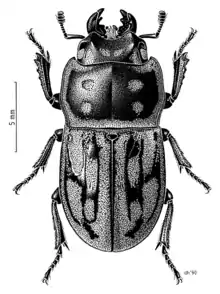Paralissotes
Paralissotes is a genus of stag beetle that are endemic to New Zealand.[1]
| Paralissotes | |
|---|---|
 | |
| Scientific classification | |
| Kingdom: | |
| Phylum: | |
| Class: | |
| Order: | |
| Family: | |
| Subfamily: | |
| Genus: | Paralissotes Holloway, 1996 |
Taxonomy
Paralissotes was described in 1996 by Beverly Holloway. New Zealand species that were previously placed in the Australian Lissotes genus were transferred to Paralissotes due to notable differences in the form of the elytral scales.[2] Paralissotes reticulatus is the type species for this genus.
Etymology
The name Paralissotes refers to how similar the genus is to Lissotes, "para" means close/near whilst "lissotes" refers to the Lissotes genus.[2]
Distribution
This genus is distributed from Three Kings Islands to as far south as Waimate in the South Island at altitudes below 1000m. These stag beetles are absent from the Chatham Islands.
Species
There are seven currently accepted Paralissotes species:[1]
- Paralissotes mangonuiensis (Brookes, 1927)
- Paralissotes oconnori (Holloway, 1961)
- Paralissotes planus (Broun, 1880)
- Paralissotes reticulatus (Westwood, 1844)
- Paralissotes rufipes (Sharp, 1886)
- Paralissotes stewarti (Broun, 1881)
- Paralissotes triregius (Holloway, 1963)
References
- Holloway, B.A. "Lucanidae (Insecta: Coleoptera)". Landcare New Zealand. Landcare Research. p. 109.
- Holloway, B.A. 1996: Two new genera of New Zealand stag beetles previously treated as Dorcus MacLeay and Lissotes Westwood (Coleoptera: Lucanidae). New Zealand journal of zoology 23(1): 61–66. doi: 10.1080/03014223.1996.9518065